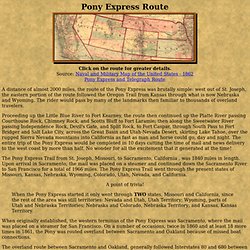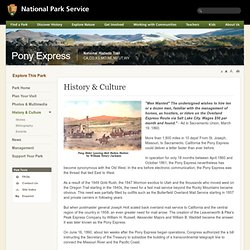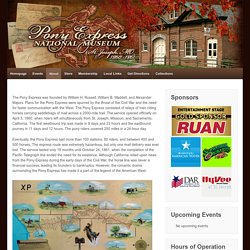Zoom
Trash

Pony Express Route. A distance of almost 2000 miles, the route of the Pony Express was brutally simple: west out of St.

Joseph, the eastern portion of the route followed the Oregon Trail from Kansas through what is now Nebraska and Wyoming. The rider would pass by many of the landmarks then familiar to thousands of overland travelers. Proceeding up the Little Blue River to Fort Kearney, the route then continued up the Platte River passing Courthouse Rock, Chimney Rock, and Scotts Bluff to Fort Laramie; then along the Sweetwater River passing Independence Rock, Devil's Gate, and Split Rock, to Fort Caspar, through South Pass to Fort Bridger and Salt Lake City, across the Great Basin and Utah-Nevada Desert, skirting Lake Tahoe, over the rugged Sierra Nevada mountains into California as fast as man and horse could go, day and night. The entire trip of the Pony Express would be completed in 10 days cutting the time of mail and news delivery to the west coast by more than half.
The Pony Express Trail from St. History & Culture - Pony Express National Historic Trail. "Men Wanted" The undersigned wishes to hire ten or a dozen men, familiar with the management of horses, as hostlers, or riders on the Overland Express Route via Salt Lake City.

Wages $50 per month and found. " - Ad in Sacramento Union, March 19, 1860. More than 1,800 miles in 10 days! From St. Joseph, Missouri, to Sacramento, California the Pony Express could deliver a letter faster than ever before. In operation for only 18 months between April 1860 and October 1861, the Pony Express nevertheless has become synonymous with the Old West. As a result of the 1849 Gold Rush, the 1847 Mormon exodus to Utah and the thousands who moved west on the Oregon Trail starting in the 1840s, the need for a fast mail service beyond the Rocky Mountains became obvious. But when postmaster general Joseph Holt scaled back overland mail service to California and the central region of the country in 1858, an even greater need for mail arose. More Pony Express HistoryThe First Ride. Pony Express National Historic Trail. Pony Express debuts — History.com This Day in History — 4/3/1860. On this day in 1860, the first Pony Express mail, traveling by horse and rider relay teams, simultaneously leaves St.

Joseph, Missouri, and Sacramento, California. Ten days later, on April 13, the westbound rider and mail packet completed the approximately 1,800-mile journey and arrived in Sacramento, beating the eastbound packet's arrival in St. Joseph by two days and setting a new standard for speedy mail delivery. Although ultimately short-lived and unprofitable, the Pony Express captivated America's imagination and helped win federal aid for a more economical overland postal system. It also contributed to the economy of the towns on its route and served the mail-service needs of the American West in the days before the telegraph or an efficient transcontinental railroad. The Pony Express debuted at a time before radios and telephones, when California, which achieved statehood in 1850, was still largely cut off from the eastern part of the country.
Pony Express Home Station. History & Culture - Pony Express National Historic Trail. Pony Express. The Pony Express was founded by William H.

Russell, William B. Waddell, and Alexander Majors. Plans for the Pony Express were spurred by the threat of the Civil War and the need for faster communication with the West. The Pony Express consisted of relays of men riding horses carrying saddlebags of mail across a 2000-mile trail. The service opened officially on April 3, 1860, when riders left simultaneously from St. Eventually, the Pony Express had more than 100 stations, 80 riders, and between 400 and 500 horses. About the Museum During the 1950s, a portion of the neglected Pikes Peak Stables in St. In 1993, the museum underwent a further renovation to restore the remaining portion of the stables to its original size.